Lower back and upper leg pain
Lower back and upper leg pain traditionally means a spinal condition but there are some indications that peripheral conditions can cause lumbago too.
Lower back and upper leg pain are common complaints at the Chiropractic Coalface. They may be connected, for example as in an irritated Femoral nerve in the lower back causing pain, or tightness, or tingling, or numbness on the side or front of the thigh, and/or groin, and down the inner lower leg.
Or they may be quite unconnected, or seemly unrelated. For example, kneecap arthritis and lower back pain.
Traditionally, in Chiropractic, the cause is in the spine (a pinched or irritated nerve) and the effect in the limb, for example, upper leg pain, numbness and/or weakness, or perhaps in an organ. The latter are far more difficult to document, but ask any chiropractor and s/he will tell you of unusual and oft unexpected results in general health. Less menstrual cramps, lower blood pressure, fewer ear infections in a child, or less constipation.
Motor Muscle Inhibition
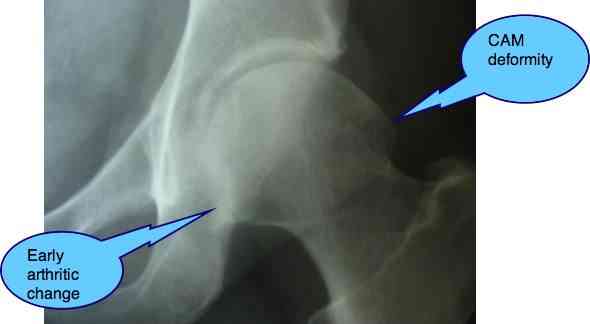
This has been very adequately theorised and demonstrated. For
example, Le Pera has shown that an irritated nerve is unable to
stimulate the muscles it serves, altering the biomechanics of the entire
region. For example, a frankly pinched Femoral nerve may cause profound
weakness in the quadriceps muscle. Can you hop on one leg without the
knee tending to give?
However, can a knee or hip condition cause changes within the spine?
Certainly a short leg ( leg length inequality, in the jargon ) can cause a scoliosis, and consequent arthritic changes within the spine. Since a short leg also causes an increased incidence of knee and hip arthritis, leg length is an important focus of Chiropractic practice.
The short leg alters the biomechanics of the lumbar spine, pelvis and knee resulting in an increased degree of pain and disability. What constitutes a short leg remains controversial.
In medical practice there needs to be at least a 10mm difference, but in my experience even a 3-5mm insert in the shoe can make an enormous difference to the health of the lower back and pelvis.
However, could a knee condition such as Patello Femoral Pain Syndrome (pain under the kneecap) or the stiff hip be the cause of arthritic changes within the spine?
Lower back and upper leg pain
Here's an interesting lower back and upper leg pain case. A 63-year old woman developed pain in the right groin some four months prior to the first consultation. Then, three months later, pain began in the right upper lower back and flank, progressing to the right lower quadrant of the abdomen.
She had pain all day, a deep ache, and pain at night too. Having a history of malignant cancer, the worst was presumed, but all tests proved negative.
On examination of the hip, internal rotation and adduction of the right hip was markedly painful in the groin, with limited range of motion: early hip arthritis OR Femoro Acetabular Impingement syndrome? Or both.
The X-ray revealed all: Both. Untreated FAIS becomes arthritic in many cases. First and foremost, a daily set of range-of-motion exercises is what is required. Simple. One minute, twice a day.
Radiologist's report: A prominent bony bump (known as a CAM deformity) is noted at the head neck junction of the femur. The appearance on the x-ray is that of acetabulum femoral neck impingement.
Meralgia paresthetica
Meralgia paresthetica is a less common cause of lower back and upper leg pain; on the side of the thigh.
Examination of the lumbar spine.
Range of motion of the lumbar spine was full, but extension and right lateral flexion caused mild pain in the right mid/upper lumbar spine. Femoral and sciatic nerve stretch tests were negative.
Reflexes and muscle strength were normal, but there was very significant numbness (90%) on the right lateral thigh. Where the Lateral Femoral Cutaneous nerve exits under the inguinal ligament was exquisitely painful.
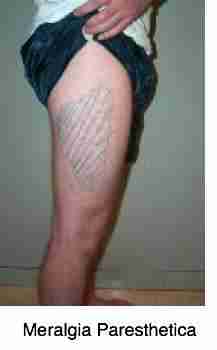
There was a right sacroiliac joint fixation. Likewise at L2 on the right.
I could add more clinical detail, but it contributes little. What is interesting is the x-ray of her lumbar spine.
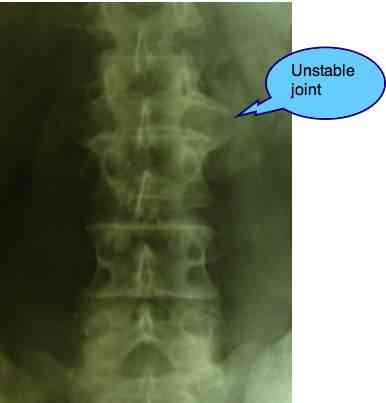
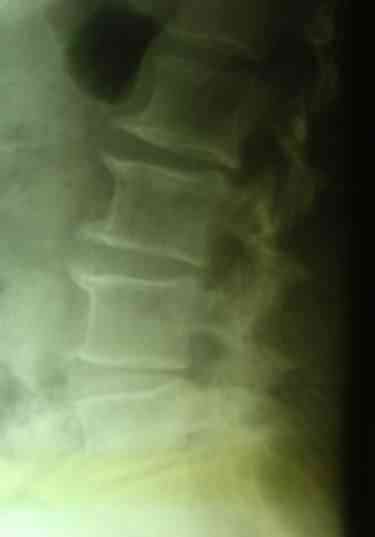
Two important features:
- Severe loss of the L5/S1 disc but at this point in time not relevant. She has no pain at this segment and no radiation in the course of the sciatic nerve. An incidental finding.
- L2-L3 and L3-L4 instability with large osteophytes that the body has built to stabilise the joints.
These are not hereditary features, there is no scoliosis, but are the result possibly of old injury, but none is recalled, or...
My point?
This lady has a congenital hip condition called a CAM deformity in her hip. (In fact in both hips, but only the right is symptomatic)
She also has acquired? lumbar spine changes in that part of the lumbar spine that supplies the capsule of the hip. This could not have caused the congenital hip condition. But could the hip condition have caused the changes in the lumbar spine?
Nociception and Neurogenic inflammation
Numerous physiologists have now shown that irritated receptors (such as mechanoreceptors) in dysfunctional joints cause inflammation in the nerves that supply them. This inflammation is transmitted to both local muscles, and also back to the spinal cord with the potential to cause weakness both at the local area of injury, and at remote sites supplied by the nerve should it have a motor component.
Could such an irritated nerve from the hip capsule cause weakness in the lumbar spine muscles? Yes, certainly. Then the body would build those large spurs to stabilise the spinal joints.
All this confirms the age-old chiropractic claims that subluxated spinal joints can have far reaching effects on joints, muscles, and even organs.
This is the area of the spine supplying the side of the leg where she is no numb, sometimes causing a condition called Meralgia Paresthethetica.
Meralgia Paresthetica is a stubborn "double-crush" syndrome where the Lateral Femoral Cutaneous nerve is irritated both in the mid/upper lumbar spine and as it exits from the pelvis under the inguinal ligament in the groin causing numbness and sometimes severe pain in the side of the thigh and/or the groin.
Medical sites report that MP is particularly resistant to treatment, but by addressing both and the upper lumbar spine, chiropractic in my experience can claim to successfully treat this knotty condition. I know of no research confirming this opinion.
Lower back and leg pain go hand-in-foot.
Tingling in feet and legs
Tingling in feet and legs is a very common complaint at the chiropractic coalface; there may be associated lower back and upper leg pain, or it may radiate down to the foot, or only be in the lower leg.
Careful evaluation is required in each and every case to make the diagnosis; very rarely even advanced arthritis in the cervical spine cause cause signs and symptoms in the leg; it's caused spinal stenosis.
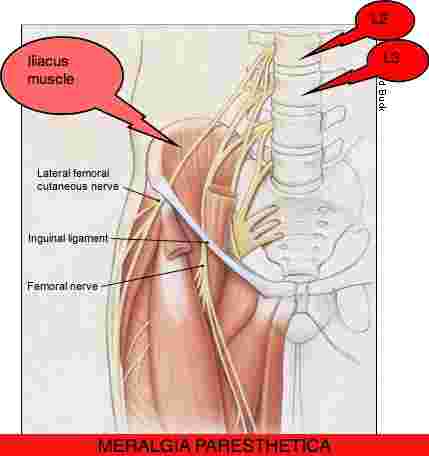
Notice the three features of this difficult case:
- The primary: a congenital hip condition (a CAM deformity) causing limitation of movement of the hip and ultimately, untreated, hip arthritis. Femoro Acetabular Impingement Syndrome ...
- A secondary? mid/upper lumbar spine instability.
- A further irritation of the LFCN causing numbness on the side of the leg.
Another not uncommon condition is an extrusion of a midlumbar disc into the intervertebral foramen; what's seemingly mystifying then is that bending backwards, and to the side provokes the pain radiating down the leg.
If it is down the back of the thigh, then it is affecting the sciatic nerve, but the front of the upper leg, groin or inner side suggests the femoral is affected.
You can see the femoral nerve in the above diagram as it proceeds down the front of the upper leg, with branches to the side and inner thigh.
I have personally had femoral nerve damage causing severe lower back and upper leg pain, radiating down to the inner lower limb below the knee; if the motor nerve is affected there will be loss of the knee jerk and and weakness of the quadriceps muscle.
Chiropractic help
All in all, lower back and upper leg pain are common complaints and chiropractic help is effective in most cases, but each and every one has to be carefully evaluated; there are many ifs and buts.
As a patient, perhaps, you are not particularly interested in the ins and outs of your condition, be it diabetes, high blood pressure, lower back and upper leg pain ... just fix it, doc.
However in these difficult syndromes, full patient participation in the treatment and after care are vital. The diabetic who won't exercise and watch his weight and diet, the hypertensive patient who won't stop smoking, the lower back and upper leg pain patient who won't stop for a period and then exercise daily... there's big trouble coming.
This particular case had a very promising start. Chiropractic Help directed at:
- Mobilising the hip
- Painful crossfriction of the hip capsule and the exit of the LFCN from the groin
- Chiropractic sacroiliac joint treatment ...
- Lumbar spine McManus traction
- A vigorous rehab programme addressing both the hip, the lumbar spine and the deep core muscles of the lower back and deep pelvic muscles. Lower back exercises ...
Within a month she was much improved and had six months of almost no pain. Then the exercises began to wane... most chronic chiropractic conditions are not cured and need on-going monitoring and maintenance care of every lower back and upper leg pain case.
- My own personal case of femoral nerve damage.
- To go from Lower back and upper leg pain to slipped disc rules.
Lower back and upper leg pain case file
Every chiropractor can write umpteen case files like this one. What makes this degenerative lumbar disc disease case file is that this elderly lady would have been red carded on two counts for consulting a chiropractor. She has osteoporosis and had severe upper leg pain.
Groin and/or thigh pain?
Do you have a question about leg pain? Share it!
What Other Visitors Have Said
Click below to see contributions from other visitors to this page...
femoral nerve impingement or torn adductor muscles? 




Hiya, I am a 100m hurdler and compete at international level. I train 8-9times a week. I was doing a regular hurdles session. I had eaten and hydrated …
Hip/femurs pain, worse at night and sitting down. Radiating can last a few days 




I first noticed left sided hip pain that radiated down my femur to my knees and heel during my first pregnancy seven yesars ago. It resolved after a few …
Lower back pain buttocks and Meralgia parasethesia Not rated yet
Hi
I have a history of lower back pain which I get a couple of times a year and can last a matter of weeks up to 3 months sometimes.
Recently during …
Lower back, upper leg, slight groin pain Not rated yet
I'm 35 years old, and I've been having mild back issues ever since a fall I took about six months back. But the problem I'm having now only started the …
Upper thigh, back and leg pain Not rated yet
Hi,
I have been having this upper thigh, back and leg pain for quite a long time.
It is on the top of my right thigh, more on the inner part of thigh, …
Femoral sensitivity relieved by sleeping on a hard surface Not rated yet
I have the need to put pressure on my right thigh by sleeping on a hard surface. The upper right thigh and near groin is sensitive to the way I walk and …
Severe back and groin pain with prominent swelling Not rated yet
Hi there, I hope you can help me? Approx 4 years ago I was in a car accident, sustained some lower back pain injuries, a small swelling appeared to the …
Low back pain on one side, radiates front to groin on bending backwards or toward the tender side. Not rated yet
Low back pain on one side, radiates front to groin on bending backwards or toward the tender side; this usually means a disc extrusion into the IVF causing …
Lower Lumbar to knee pains Not rated yet
Greetings,
I had a 6k lb. Ford Expedition turn over me on my motorcycle 11/2/2015. I sacrificed my L2 to S2 left lower back (2" from spine convex muscle …
healthy athletic 45 year old woman Not rated yet
I was acutely stricken 4/2016, started 4 days before with pain in right groin, assumed just needed stretching; woke unable to stand more than an L shape, …
Lower back pain/hip/leg and groin ache Not rated yet
About 4 months ago I started getting shooting pains in my left outer thigh. It comes and goes. I also get lower back pain and ache.
About a month ago …
Leg pain Not rated yet
Dull pain on outside of left leg adjacent to buttocks, below hips but above thigh. Does not always cause bother but is aggravated when walking upstairs, …
leg pain and at time leg will buckle Not rated yet
My leg just under the butt cheek hurts and it makes it hard if not impossible to walk. The pain will move to where there was none the next time.
I …
Pubic symphysis & hip pain help? Not rated yet
I'm 4.5 months post partem. I was diagnosed with pubic symphysis dysfunction after my first pregnancy and it got severe with this most recent pregnancy. …
Did you find this page useful? Then perhaps forward it to a suffering friend. Better still, Tweet or Face Book it.
